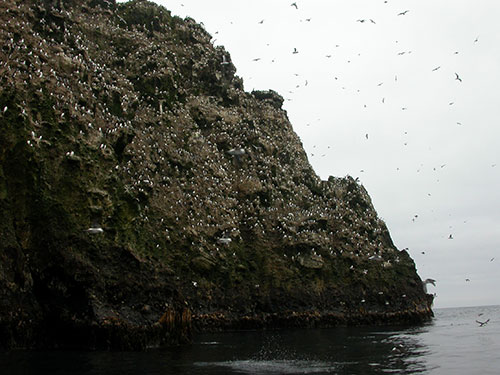
Tidal stresses and giant earthquakesBy NED ROZELL
January 26, 2015
Yen Joe Tan of Columbia University is combing through a database of offshore Alaska earthquakes to see if there is any link between the number of small earthquakes triggered by tides and great earthquakes that send tsunamis racing thousands of miles.
Buldir Island, with its tremendous population of seabirds, lies halfway between Attu and Kiska islands near the western end of the Aleutian Islands and just north of the Aleutian Trench, home to giant earthquakes.
A Japanese researcher has studied the relationship between tides and earthquakes. Sachiko Tanaka of the National Research Institute for Earth Science and Disaster Prevention in Tsukuba, Japan, found that tidally triggered earthquakes were common off the northeast coast of Japan several to 10 years before the magnitude 9 earthquake that triggered the tsunami in 2011. She found similar results when she went back and looked at data from around Sumatra before the 2004 tsunami. “She showed a small nudge by tidal stress can push it over the limit,” Joe Tan said. Using records of past earthquakes, Joe Tan wants to see if any parts of the Aleutian Arc are perhaps giving the same signals. Though his data are much more sparse than that available to Tanaka, he has seen three areas that seem to increase in seismicity when tidal forces are high. Those zones are southeast of Kodiak, south of Tanaga in the central Aleutians and south of Buldir in the western Aleutians. “They might be currently critically stressed,” he said of these areas. The potential for a giant earthquake along the sweep of the Aleutians is no secret. When U.S. Geological Survey scientists and others last year imagined an earthquake/tsunami scenario that would affect millions on the anniversary of the 1964 Good Friday earthquake, they chose a fictional magnitude 9.1 epicentered just south of Sand Point. The Alaska effects would be terrifying and deadly, and the researchers estimated the resulting tsunami would inundate the ports of Los Angeles and Long Beach, crippling a supply system we all depend upon. Yen Joe Tan hopes to see if his approach of using statistics could be useful in improving forecasting earthquakes in great subduction zones, like the one where southern Alaska meets the sea.
|
||
